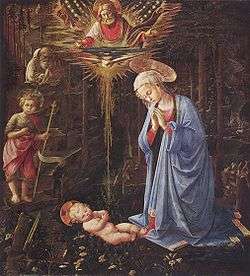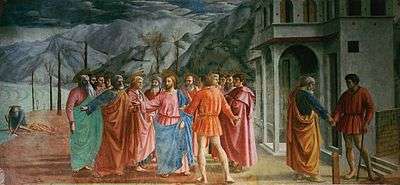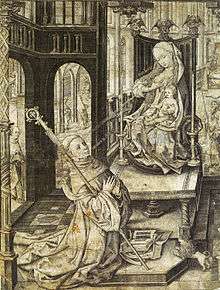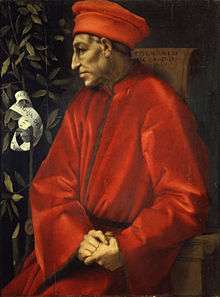Adoration in the Forest (Lippi)

Adoration in the Forest is a painting completed before 1459 by the Carmelite friar, Filippo Lippi, of the Virgin Mary and the newly born Christ Child lying on the ground, in the unusual setting of a steep, dark, wooded wilderness. There are no shepherds, kings, ox, ass – there is no Joseph. "Lippi removes a whole range of narrative details which would have been present in a standard Nativity - he creates a whole set of mysteries, and then preserves them."[1] It was painted for one of the wealthiest men in Renaissance Florence, the banker Cosimo de Medici. In later times it had a turbulent history. Hitler ordered it to be hidden in WW2 and it became part of the story of a mutiny in the U.S. Army - 'the only known case in the whole Second World War of American officers refusing an order.' It is now once again in the Gemäldegalerie, Berlin.
Cosimo de Medici and Filippo Lippi
Florence in the 1440s was at an expansive moment in its history. A lot of money was going into building, including the future home of Lippi's Adoration, Cosimo de Medici's Palazzo Medici. Cosimo was the wealthiest man in Florence, a man of power, an adept Italian politician and his home spoke of an attitude of powerful confidence. Yet, in private, he was also a troubled man. He had led a sinful life, had fathered a bastard child on a slave girl, and grown rich by lending money and charging interest – usury – a practice to be punished by an eternity in Hell. Tim Parks: " He was a genuinely religious man, concerned about his soul, and that was a rather large problem for a banker."[2] He set about making amends for his sins in building and art. "Inside his new palace, the first domestic chapel built in all of Italy, as a peace offering to God; a place for Cosimo to kneel and do penance. The walls were decorated with extravagant frescoes, including a portrait of Cosimo himself. But the heart of the room would be the altarpiece - this would be a Nativity, but of a kind never seen before, one that would echo Cosimo's very deepest hopes and fears. " He chose an artist famous not just for his art, but one whose eye for beauty extended beyond pictures, to women, with scandalous results; - a Carmelite friar - Fra Filippo Lippi. Born in Florence around 1406, Lippi's father was a butcher, and the family home on the south bank of the Arno River. By the age of 8 Lippi was an orphan, and placed into the care of the local convent, Santa Maria del Carmine, which towered over the neighbourhood. So Lippi had not chosen to become a monk, but was to be trained to be one. It was a fortunate home for a youngster of an artistic bent; in the 1420s a chapel there was being decorated - 'and the result was one of the most groundbreaking and beautiful works of the Italian Renaissance.

The artist was Masaccio. In his art, "Biblical characters suddenly seemed real people..lit by the sun...moving in the real world, convulsed by real emotions.' Jeffrey Ruda: " Masaccio's work was profoundly important for Filippo Lippi - it gave him a profoundly new way to think about representation, about showing figures, using light and shadow to bring out a sense of shape and presence and to give the figures placement in a world that was grounded in gravity." "Lippi's earliest surviving work shows the influence of Masaccio's bold sculptural figures, transformed by a grace and delicacy that were Lippis own." By the age of 30 Filippo Lippi had left the convent and begun to earn a living as a professional artist though he remained a friar. As the years passed, his growing fame drew him inexorably into the circle of the city's leading artistic patron, the de facto ruler of Florence, the man who would commission The Adoration, Cosimo de Medici. At first Cosimo paid Lippi to produce pleasing religious scenes for his new home. Lippi had, all the while, the reputation of a man who liked to live life to the full - but in the late 1450s real scandal broke, and Lippi embroiled in a Nativity all of his own. For three years he had been working in the small town of Prato, near Florence, painting a huge fresco cycle in the Cathedral – also conducting a daily Mass – in the local nunnery. The story goes that he persuaded the abbess to let a young nun he liked - Lucrezia Buti - sit for him - and then she and Lippi absconded together. Just 20 at the time, Buti's seduction by the 50-year-old friar threw Prato into an uproar. A son Filippino Lippi, later a famous painter himself, duly arrived. Cosimo however, smoothed over any scandal and Lippi returned to Florence to create Cosimo's groundbreaking Nativity.
John the Baptist, Bernard of Clairvaux, the Trinity

It is likely that the patron and the artist discussed the plan for the altarpiece carefully – it would need to reflect and deepen Cosimo's penitent mood. The painting was a defining example of a new genre in art – The Adoration – which focuses intensely on Mary and the Infant Christ, and for this Lippi drew upon the teachings of a medieval saint, Bridget of Sweden, who in visions had seen exactly how Christ had entered the world. "This wasn't God floating amid the cumuli, this was God made man, put amongst the rocks, the very stuff of which our world was made."[3]
And instead of shepherds and wise men, Lippi introduced two humbly dressed saints, fitting role models for the wealthy patron. John the Baptist, said to have left home at the age of 7 to lead an austere life in the desert, here wears his traditional hair-shirt and carries a scroll that proclaims in Latin, Behold the Lamb of God. Above him, kneeling behind a natural prayer-stool of rock, is a monk, Bernard of Clairvaux, the founder of the Cistercian Order – a monk who had a particular devotion to the Virgin Mary, – here he faces her, lost in meditation. The two saints are not the only unexpected presence - few, if any, previous Nativities had included the entire Holy Trinity - God the Father, His Son, and the dove of the Holy Spirit. It was a subject dear to Cosimo, after he helped to resolve a theological dispute about the nature of the Trinity and is depicted here wreathed together in rays of celestial light. But the painting also has a darker side. All round the new-born Christ child wild flowers grow, their delicacy concealing a sombre meaning - their five petals represent the Five Wounds Jesus will receive during his Crucifixion. Such symbols abound – on the ground a goldfinch rests – the bird that feeds on the seeds of the thorn bush, calling to mind the Crown of Thorns. Further, there is the unsettling landscape, not a stable or open rolling countryside, rather, immersed in a dark dense forest - "this was Lippi's innovation and Cosimo's obsession." Lippi chose an unusually specific landscape - it is the high woods at Camaldoli, east of Florence, where in the 11th century Romuald had founded a monastery, to which the Medici were very devoted. The Medici would have recognised at once the landscape, resonant with the austere and ascetical spirit of one of the great monastic orders, the Camaldolite Order. Camaldoli had another specific link to the painting: the monks there ran a timber business, chopping down the tall pines of the forest to provide wood for the buildings of Florence. These fallen trees are strewn through the painting and would have reminded Cosimo of the Biblical words of John the Baptist (Gospel of Matthew, chapter 3) :Now the axe is laid unto the root of the trees, and in the end, every tree that does not bear good fruit is cut down and thrown into the fire - a clear evocation of the Last Judgment, of the end of time. "Cosimo is a tall tree..."

Lippi painted using tempera, coloured pigments bound in egg-yolk, the standard medium of the day. This, " has to be applied very gently, very delicately, little parallel strokes, literally stroking paint on to the surface. A great master like Lippi would have created seamless transitions which are barely visible now..He must have had wonderfully fine brushes, I don't know how many he got through each day, wearing them out." Lippi knew that his painting was to be displayed in a very particular environment, the windowless chapel of the Medici palace, so it would be seen only by candlelight. A small part of Mary's cloak bears traces of damage from the naked flame of an altar candle. Lippi used the darkness, and finished the painting with a breathtaking display of gold. His use of gold was both, "very extravagant and virtuoso, but also very restrained..halos with their incised and punched decorations..and sometimes he's not even using gold, he's using little dots of yellow and ochre to suggest the play of light across a golden surface, set next to actual gilding." For Cosimo, the banker, the gold might also have held a very personal meaning. Tim Parks: "To me , the most important part of the picture is the amount of gold that's used, this extraordinary superimposition of cash and the sacred - the darkness at the centre of the painting does nothing but set off the gold here. He wanted to make his money religiously respectable - I think that's absolutely key to the whole thing..." Unlike most artists of the day Lippi chose to sign his picture, on the handle of the axe, 'with panache, in a virtuoso display of foreshortening.' By the year 1459 Lippi's work was finished, and the painting placed above Cosimo's private altar. Four years later, Cosimo died. Lippi's fame continued to grow - he fathered another child with Lucrezia and the Pope offered to release the couple from Holy Orders so that they could be married - Lippi declined. A decade after finishing his Adoration Fra Filippo Lippi died. Lippi's inspiration continued - the young Sandro Botticelli, once Filippo Lippi's pupil, adopted his style and Michelangelo praised him. Soon his Adoration had become one of the most copied paintings of the 15th century, an image in demand for the houses of the rich and poor alike. Yet its fame did not mean it was secure in its home, and it faced threats from rebellion and war.
Fate of the painting
In 1494 the Medici family was expelled from Florence, their palace ransacked, and many statues and paintings carried off. The most important artworks were seized by the state and taken to the seat of government, the Palazzo della Signoria. Lippi's Adoration was installed over the altar of the Republican government's own chapel. Just two decades later however the Medici returned to Florence in triumph and moved back into their palace - citizens and state alike gave up their looted art and so the Adoration found its way back to its original home. It remained there for three centuries, until the first years of the 19th century, when a wealthy English trader living in Prussia, Edward Solly, entered its story. Solly was a merchant who had settled in Berlin, a trader in timber and grain - Prussia lived off trade with these goods and trade to Britain was an important part of the Prussian economy. He had become one of the wealthiest men in Berlin and had a palatial mansion yards from the Brandenburg Gate. He also had a passion for early Italian art and had begun to build up an extraordinary collection of over 3000 paintings, the largest private collection of western art in the world. It was a good moment for collectors - Napoleon I was in control of Italy and had imposed punitive taxes on its wealthy families, forcing them to sell off much of their art - Solly acquired Lippi's Adoration, most probably for just a few pounds.

But it was Napoleon who was also to prove the undoing of Solly when he established a naval blockade across the seas of Europe. "Solly was one of the people very personally affected by that because his own specialty was no longer possible - legally at least." At first Solly did well, making huge profits, as his merchant ships ran the blockade, but then disaster struck. The Danish, allies of Napoleon, seized no fewer than 20 of his ships, complete with cargo. Solly was in danger of going bust - his proposed solution - to sell his entire art collection to the Prussian state. The price, 500000 thalers, represented 1% of the entire state budget, but it was still a bargain. In 1821, at a stroke, when the deal was sealed, Prussia could boast one of the finest art collections in the world. Lippi's Adoration now went on display to the general public for the first time, at the Royal Museum, Berlin, - ' and Lippi's star was in the ascendant.' A real appreciation of Renaissance culture was abroad, and it was also the time of the arrival of Romanticism - the birth of the notion of the artist, 'as mad, bad, and possibly sad, in order to be wonderfully creative, and Lippi and his affair with Lucrezia Buti was irresistible.'[4] In the year the Prussian state bought his Adoration the artist Paul Delaroche painted Lippi with Buti, and many other artists had an eye for a fallen nun. By mid-century poets had joined the Lippi cult, - Robert Browning, living and working in Florence, published an imaginary monologue in which a drunken Lippi tottered through the backstreets of the city proclaiming his libertarian creed : You should not take a fellow eight years old, And make him swear to never kiss the girls. I'm my own master..

In Berlin its fame quietly grew but the new twentieth century brought new threats. 1940: the Nazi authorities put into action careful plans to keep its art treasures safe. Renaissance art was particularly prized and Lippi's altarpiece described as unersetzlich, irreplaceable. Strange as it seems, the safest place in Berlin was deemed to be an anti-aircraft installation, the Friedrichshain Flak tower - 'the bunkers had concrete walls of 3 metres and more', and for five years, deep inside the flak tower the painting remained. But by 1945 Berlin was about to fall and at the last moment an order came from Hitler for the paintings to be evacuated. Under cover of darkness they were transported to the small town of Merkers and hidden deep underground in a potassium mine. Lippi's sacred masterpiece was housed alongside Nazi gold and the stolen jewelry of concentration camp victims. In April 1945 American troops found the art treasures. And soon the American authorities made a stunning decision. The art, they said, should be treated as reparations and taken to the U.S. on the basis of a so-called trusteeship. The troops who had salvaged the art from the mine, specialist officers, known as Monuments Men were now told to ready it to be shipped out. In an unprecedented turn of events they refused. It is 'the only known case in the whole of the Second World War of American officers refusing an order.' Anne Webber, (Commission for Looted Art in Europe): 'The Nazis had committed the greatest art thefts in history, seized hundreds of thousands of works of art and they were to be prosecuted at Nuremberg..the Monuments Men said there was no distinction in their minds between what the Germans had done in 'safeguarding art' and what the Americans were doing on the same pretext.' Eventually though, amidst threats of courts martial the Monuments Men gave way. 202 of the very finest artworks, Lippi's Adoration among them, were picked out and prepared for shipping to Washington. Upon arrival their condition was assessed - Lippi's after 6 years of war - 'fair, undamaged' - but by now, public opinion was turning decisively against American appropriation of the paintings. Putting them on display no longer seemed wise - instead they were hung under armed guard in the National Gallery of Art underground vaults, for three years, before it was decided that the artworks should after all be sent back to Germany. But not before an extraordinary event took place at the National Gallery of Art and they went on display, a 'blockbuster exhibition', 'the crown jewels of the German collections'; in the first week, 100,000 people came. Following public wishes for wider access, the paintings were toured through 12 other cities so that over 10 million came to see them. In 1949 Lippi's Adoration returned to Germany. Over the coming years, in a politically divided Berlin, it would hang in a succession of temporary homes until the new Gemäldegalerie was finally built. Here it presides over a room especially designed for it - and is one of the prize exhibits.
References
- ↑ Luke Syson, National Gallery, London, speaking in The Private Life of a Christmas Masterpiece, Tx BBC Two, 25.12.2010
- ↑ Parks, author of Medici Money, speaking on Private Life of a Christmas Masterpiece, BBC 2010
- ↑ Rachel Campbell Johnston, critic The Times, speaking on Private Life of a Christmas Masterpiece.
- ↑ Sarah Dunant, speaking on 'PLOACM'
External links
| Wikimedia Commons has media related to Adoration in the Forest by Fra Filippo Lippi. |